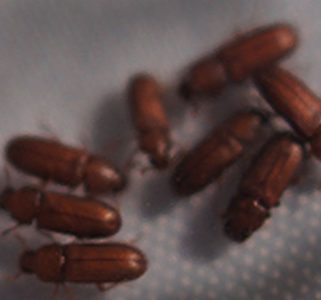INTRODUCTION
Quick Navigation
The problem that most cigar smokers have with the cigar is the cigar beetles. It is quite frustrating and annoying when cigar beetles can eat into and ruin your cigars while causing a whole lot of damage to your favourite cigars. It doesn’t take much for a colony of cigar beetles to invade your cigar collection and wreak havoc on it. Infestations of cigar beetles can develop a big problem for cigar fanatics. Not to worry, this article is detailed with tips to help you fight these beetles.
The scientific name of cigar beetles is lasioderma serricone are they are very tiny beetles, mostly 2-3mm long. These tiny insects can fly and live up to six weeks which is long enough to cause huge issues on your cigar collection. Apart from their names, these beetles do not feed on cigars or tobacco alone but can also be found in areas were food like spices, coffee beans and cereals are stored.
SYMPTOMS OF CIGAR BEETLES INFESTATION
PINHOLES
This is one significant way to know when cigar beetles have attacked your cigar collection. It would be best if you inspected your cigars regularly. If you notice small holes in your tobacco wrapper, then you probably have a cigar beetle problem. Sometimes, this may be overlooked because cigar wrappers are typically delicate and can get torn on their journey to you. However, these cigar beetles tend to make flawlessly round holes that look like holes made from a needle or pin by chewing through the tobacco wrapper. These holes are known as pinholes. Sometimes it might be just one or two holes.
BLACK DUST
It is easy to confuse this black dust with tobacco crumbs or remnants. Note that they are different. Black dust is tiny black particles that can be found at the bottom of your humidor. If you don’t move your cigars around regularly, just softly hit/ tap the bottom part of your cigar on the edge of the humidor. If you notice a fair amount of black dust fall out, you most likely have a cigar beetle infestation. The black dust is the faeces of these beetles and is quite disgusting.
It is not advisable to still smoke a cigar that has been infested by these beetles as it Is very unhealthy. It is better to dispose of the cigars if you notice any of these symptoms.
WHERE DO CIGAR BEETLES COME FROM AND WHAT ARE THEY?
Cigar beetles are tiny beetles that cannot be seen with the naked eye. The female cigar beetles usually sneak into the tobacco during the process of production and lay eggs inside the tobacco. As soon as these eggs begin to hatch, the maggot start to eat their way out of the tobacco, and they also excrete tobacco as they eat, this is what makes up the black dust.
When these eggs get to the surface, they dig their way out of the cigar wrapper by eating through it while creating pinholes. This is quite unsafe because these beetles can then move onto the other cigars in your cigar collection and repeat the cycle.
HOW TO PREVENT CIGAR BEETLES
- MAINTAINING THE PROPER HUMIDITY AND TEMPERATURE OF YOUR HUMIDOR
You may not be able to guarantee that keeping your humidor at a specific humidity or temperature will keep the cigar beetles at bay, but it will help to an extent. Remember to keep the temperature and humidity of your humidor at 65-70 degrees and less than 70% humidity. This will help to keep your cigars in good shape.
- TEMPORARILY FREEZE YOUR CIGARS
This is the most effective way to preserve your cigars and kill the cigar beetles instantly. When you freeze your cigars, it’ll wipe out the unhatched eggs that may still be in your tobacco. Freezing your cigars will stop the hatching process and avoid ruining and the eating of your cigars.
FREEZING CIGARS TO PREVENT CIGAR BEETLES
You can follow the following steps to prevent the growth and infestation of your cigars:
- Place your cigars in a double-bagged Ziploc bag
; It is advisable to double the bag if possible, to ensure that no moisture can get into the bag. Also, make sure you use a Ziploc bag of high quality. Using an inferior Ziploc bag may allow moisture to get into the bag and cigars.
- Remove the air from your Ziploc bags
To ensure optimal condition, open up the bag and squeeze it to remove all air from inside.
- Refrigerate the cigars for 24 hours
You may have to introduce your cigars into the coolness of a refrigerator before placing them in the freezer. It is not advisable to just freeze them immediately.
- Place the cigars in the freezer for 48 hours
Freezers may vary in temperature, but for most cases, 48 hours is enough time to get rid of these insects and keep your cigar fresh.
- Place the cigars back in the fridge for 24 hours
Youll have to refrigerate the cigars once again to unfreeze them and have them ease back into a less cold temperature to help them quickly recover.
- Return your cigars to their storage or humidor
Now, you are all set to return your cigars to their former home without having to bother about the cigar beetles.
CONCLUSION
If you’re sure that you have a cigar beetle infestation, then its better to just dispose of the infected cigars and clean pout your humidor to get rid of the beetle’s maggot and faeces.
If you follow these prevention steps, you shouldn’t have a problem with cigar beetles. Always remember to crosscheck and inspect your cigars regularly and properly to avoid total infestation. It is better not to consume an already fully infested cigar. You can cut open the cigars when you notice the pinholes or black dust to full access the damage that has been done.
Also, remember to double-check your new batch of cigars when you receive them before placing it in your humidor.
Also check;

